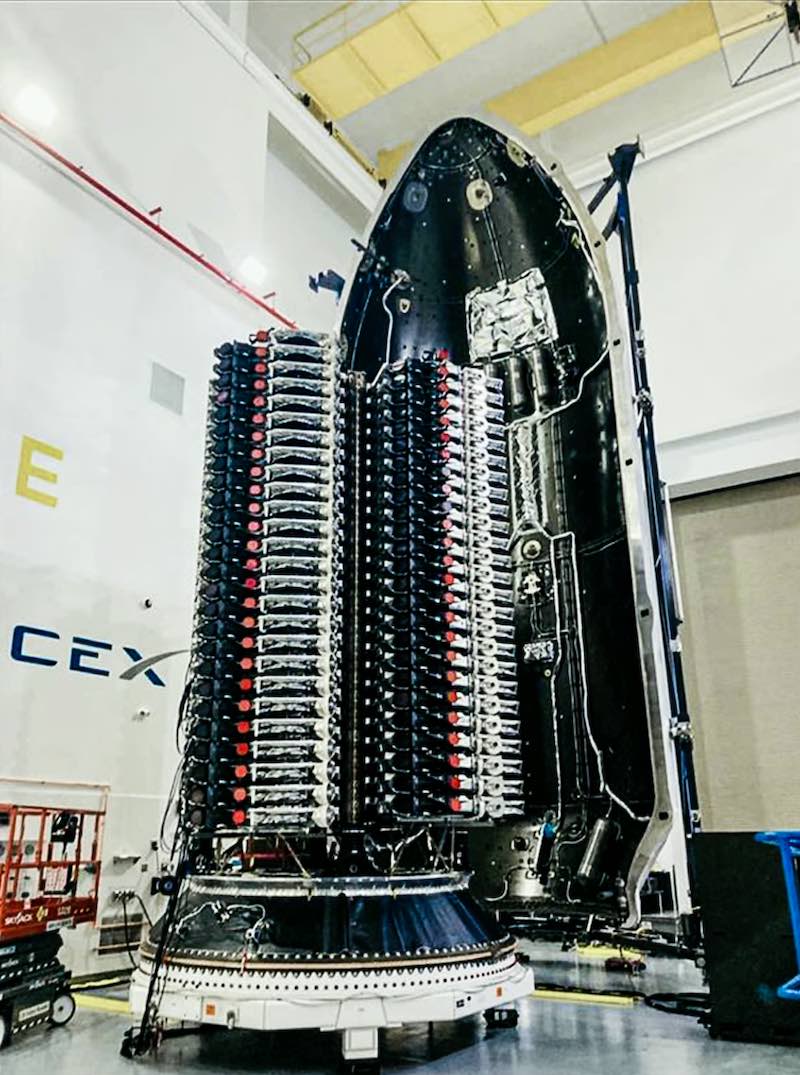
SpaceX raised a Falcon 9 rocket vertical on pad 39A at the Kennedy Space Center Thursday, ready for a pre-sunrise blastoff Friday with 53 more Starlink internet satellites, using a booster stage flying for a record-tying 12th time.
Liftoff is set for 5:42 a.m. EDT (0942 GMT) Friday to begin SpaceX’s 152nd Falcon 9 launch, and the company’s 18th launch of the year. It will be the 44th SpaceX mission primarily dedicated to launching satellites for the company’s privately-funded Starlink broadband network.
The timing of the launch, about an hour before sunrise, could yield spectacular results for skywatchers across Central Florida and along the U.S. East Coast as the Falcon 9 climbs into sunlight. The rocket will arc toward the northeast from Cape Canaveral to target one of the orbital planes, or pathways, in the Starlink constellation.
SpaceX plans to load a million pounds of densified kerosene and liquid oxygen propellants into the two-stage Falcon 9 rocket beginning about 35 minutes before liftoff, then run the launcher through customary pre-flight checkouts, chilldown, and pressurization steps before igniting nine Merlin 1D main engines at T-minus 3 seconds.
After an automated health check, hydraulic hold-down clamps will release to free the Falcon 9 to begin its vertical climb from pad 39A, powered by 1.7 million pounds of thrust.
There’s a better than 90% chance of favorable weather for launch Friday morning, with mostly clear skies forecast at the Kennedy Space Center, according to the U.S. Space Force’s 45th Weather Squadron. There is a moderate risk of out-of-limits upper level winds,
The Falcon 9’s first stage, tail number B1058 in SpaceX’s inventory, will shut down about two-and-a-half minutes after liftoff to begin a descent toward the company’s drone ship “A Shortfall of Gravitas” parked a few hundred miles downrange in the Atlantic Ocean.
The propulsive landing is scheduled about eight-and-a-half minutes after liftoff, moments before the Falcon 9’s second stage engine completes its first firing to place the 53 Starlink satellites into a parking orbit. The booster stage will become the third in SpaceX’s fleet to fly 12 times, the current record for Falcon 9 stages.
This booster debuted in May 2020 with the launch of the first test flight of SpaceX’s Dragon spacecraft to carry astronauts.
The Falcon 9 will reignite the upper stage’s Merlin-Vacuum engine about 45 minutes into the mission, setting the stage for separation of the 53 Starlink satellites at T+plus 54 minutes, 30 seconds.
Retention rods holding the satellites into a flat-packed configuration on the rocket will jettison, allowing the Starlink platforms to fly away from the second stage. They will unfurl solar arrays and run through automated activation steps, then use krypton-fueled ion engines to maneuver into their operational orbit.
The Falcon 9 will aim to deploy the satellites in a near-circular orbit ranging in altitude between 189 miles and 197 miles (304 by 317 kilometers), at an orbital inclination of 53.2 degrees to the equator. The satellites will use on-board propulsion to do the rest of the work to reach a circular orbit 335 miles (540 kilometers) above Earth.

The Starlink satellites on Friday’s mission will fly in one of five orbital “shells” used in SpaceX’s global internet network. After reaching their operational orbit, the satellites will enter commercial service and begin beaming broadband signals to consumers, who can purchase Starlink service and connect to the network with a SpaceX-supplied ground terminal.
After Friday’s launch, designated Starlink 4-17, SpaceX will have deployed 2,494 Starlink satellites in orbit, including spacecraft that were decommissioned or suffered failures. More than 2,100 of those satellites are in orbit and functioning as of this week, according to a list maintained by Jonathan McDowell, an astrophysicist who tracks spaceflight activity.
That makes the Starlink fleet the largest satellite constellation in the world, by a factor of nearly five over the internet satellite fleet owned by rival OneWeb.
SpaceX is in the midst of launching some 4,400 Starlink satellites into the network’s five orbital shells. The first of the five shells was filled last year, and SpaceX is expected to begin launching into additional shells later this year. All of the orbits are located between 335 and 350 miles above Earth, while some are in mid-inclination orbits — like the orbit targeted on Friday’s mission — and others are in polar orbits.
Email the author.
Follow Stephen Clark on Twitter: @StephenClark1.
from Spaceflight Now https://ift.tt/Ev0pmDC
via World Space Info







0 comments:
Post a Comment